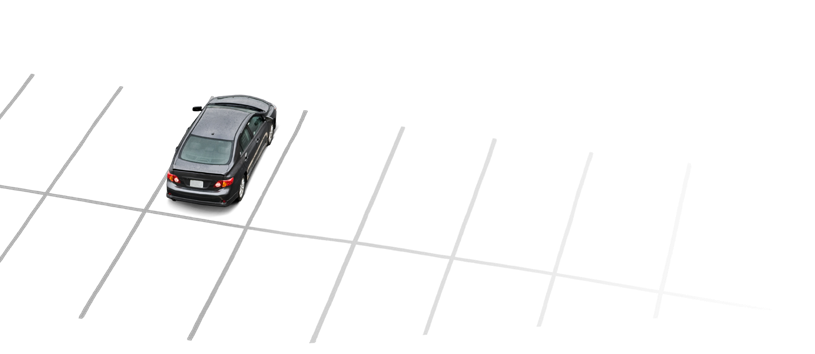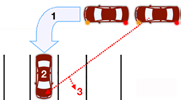
Sessions 14 - 16
Sessions 14-16

Parking
Sessions 14-16 focus on learning the correct procedures for angle, perpendicular, and parallel parking using reference points and commentary driving. Review previous lesson objectives and the driver’s manual section on parking. Begin Session 14 in a large, level parking lot free of obstacles. Practice parking in the school parking lot during session 15, and spend session 16 practicing parking in a shopping mall parking lot. During each session have your teen practice angle, perpendicular, and parallel parking on the right and the left 10-12 times. Coach your teen to select a parking space that requires no backing when possible.
Angle Parking Steps
-
 CaptionAngle Parking Steps
CaptionAngle Parking Steps - Move forward until the steering wheel is aligned with the first pavement line.
- Visually locate the middle of the parking space, check traffic and path of travel, and turn the wheel sharply at a slow controlled speed.
- Steer toward the target in the center of the space to straighten the wheels and stop when the front bumper is 3-6 inches from the curb or end of the space.
- If you have a choice, parking on the left gives you more room to maneuver and a better view of traffic if you have to back out of the space.
Exiting an Angle Parking Space
- Place foot on brake, signal intention, and shift to reverse.
- Check traffic and path of travel, and back straight back until your vehicle’s front seat is even with the bumper of the vehicle located on the turning side, and slowly begin turning the steering wheel in the direction you want the rear to go. Continue checking traffic as you back your vehicle.
- Monitor your front bumper on the opposite side of the direction you are turning.
- When your front bumper clears the back of the vehicle by several feet, stop, and shift to drive.
Perpendicular Parking Steps (parking at a 90-degree angle)
-
 CaptionPerpendicular Parking Steps
CaptionPerpendicular Parking Steps - Move forward until the side view mirror is aligned with the first pavement line.
- Check traffic and path of travel, and turn the wheel rapidly left or right controlling speed.
- Steer towards the target in center of space and straighten the wheels.
- Position the front bumper 3-6 inches from the curb or end of the space.
Exiting a Perpendicular Space
- Place foot on brake, signal intention, shift to reverse, and look through the rear window.
- Check traffic and path of travel, and back until your windshield is even with the bumper of the vehicle located on the turning side, and begin turning the steering wheel in the direction you want to go. Continue checking traffic as you back your vehicle.
- Monitor your front bumper on the opposite side of the direction you are turning.
- When your front bumper clears the back of the vehicle by several feet, stop, and shift to drive.
Parallel Parking Steps
-
 CaptionParallel Parking Steps
CaptionParallel Parking Steps - Stop 2-3 feet parallel to the car in front with the rear right tire even with the other vehicle’s back bumper.
- Shift to reverse. Check traffic behind and path of travel, and back slowly steering sharply left or right as appropriate; stop when the side view mirror is in line with the rear bumper.
- Continue backing slowly while steering rapidly in the opposite direction using quick glances to the front and the rear of the vehicle until the vehicle’s wheels are straight.
- Center vehicle in space. Wheels should be 6-12 inches from the curb.
Exiting a Parallel Parking Space
- Brake, shift to reverse, and back as near as possible to the vehicle behind you.
- Check traffic, signal, and shift to drive.
- Move forward slowly while steering rapidly out of the space.
- Begin straightening wheels when your vehicle’s front seat is even with the back bumper of the car in front and look at the target in the center of your path of travel.
Parking on a Hill
When parking uphill or downhill, make sure your teen places the vehicle in REVERSE or FIRST gear for manual transmissions, and PARK for automatic transmissions, and that the parking brake is properly engaged. To further ensure that the vehicle does not roll into traffic, turn the front wheels:
- towards the curb when parking downhill;
- towards the curb when parking uphill without a curb; and
- away from the curb when parking uphill with a curb.